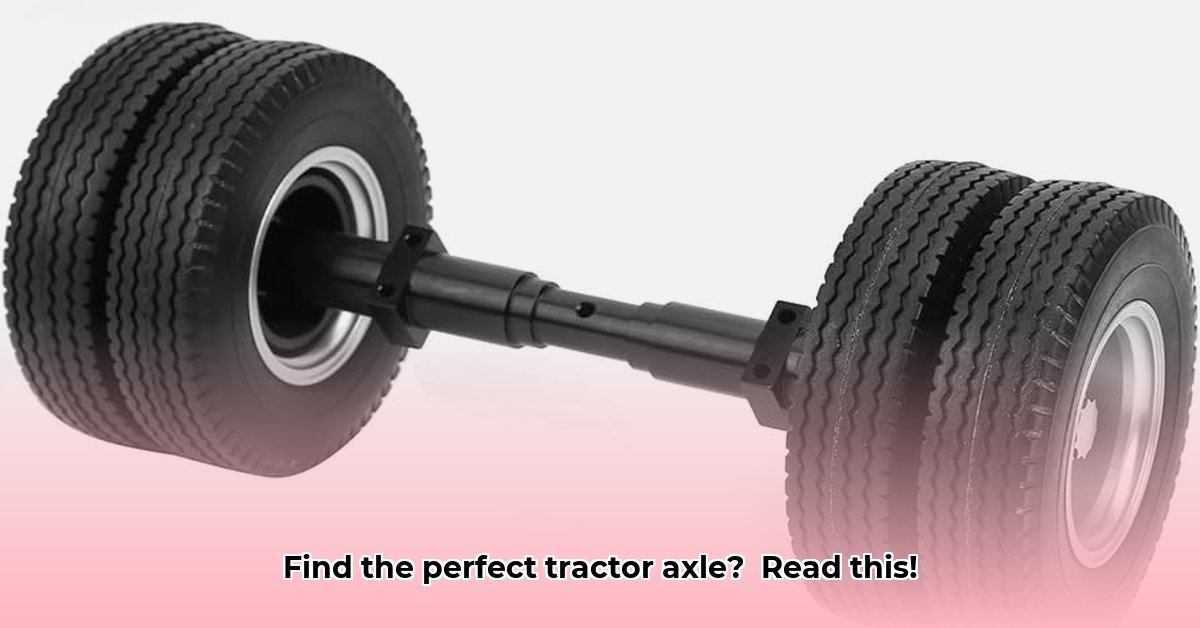
Axle Tractor: Selecting the Optimal Front Axle for Your Farm
Choosing the right tractor is a significant investment. Often overlooked, the front axle plays a crucial role in your tractor's performance, efficiency, and safety. This guide will help you understand the different axle types – standard, high-crop, and tricycle – and select the best option for your farming operation. For more tractor information, check out this helpful tractor resource.
Understanding Your Farming Operation: A Crucial First Step
Before delving into the technical specifics, consider your farming practices. What type of crops do you cultivate? What is the size of your operation? What are the characteristics of your fields (e.g., flat, hilly, tight rows)? These factors significantly influence the most suitable axle type. For example, a large-scale operation with wide-open fields will have different needs than a smaller farm with densely planted rows.
Standard Axles: The Versatile Workhorses
Standard axles are the most prevalent type. They are robust, reliable, and designed for heavy-duty tasks and pulling large implements. Many allow for adjustable wheel width, making them versatile for various row crops. However, their maneuverability in confined spaces might be limited.
Pros:
- High durability and load capacity.
- Excellent stability.
- Wide availability and ease of maintenance.
Cons:
- Limited maneuverability in tight spaces.
- May damage crops in close-row plantings.
High-Crop Axles: Maximizing Ground Clearance
High-crop axles offer increased ground clearance, essential for working with tall crops like corn or sunflowers. This prevents damage to the plants and increases efficiency. However, they represent a specialized, and often more expensive, investment. Do you need the extra clearance, or is it a "nice-to-have"?
Pros:
- Exceptional ground clearance for tall crops.
- Minimizes crop damage.
Cons:
- Higher initial cost.
- Potentially limited availability compared to standard axles.
Tricycle Axles: Prioritizing Maneuverability
Tricycle axles, featuring a single front wheel, provide superior maneuverability, particularly beneficial in confined spaces like orchards or vineyards. However, this agility comes with a trade-off: reduced stability compared to other axle types, increasing the risk of rollover accidents. Modern farming practices often favor the enhanced stability of other axle types.
Pros:
- Exceptional maneuverability in tight spaces.
- Ideal for row-crop farming with very narrow rows.
Cons:
- Lower stability, increasing rollover risk.
- Generally less versatile than standard axles.
Axle Types Compared: A Quick Reference Table
| Axle Type | Advantages | Disadvantages | Ideal Applications |
|---|---|---|---|
| Standard | Durable, versatile, widely available | Less maneuverable in tight spaces | Large-scale farming, heavy pulling tasks |
| High-Crop | Excellent ground clearance for tall crops | More expensive, potentially limited availability | Crops requiring high ground clearance (tall corn) |
| Tricycle | Superior maneuverability in confined spaces | Lower stability, less versatile | Small farms, orchards, vineyards |
Choosing Your Axle: A Practical Step-by-Step Guide
- Assess your farming operations: What are your primary tasks? What crops do you grow? What is the terrain like?
- Consider your budget: High-crop axles typically command a higher price than standard axles.
- Evaluate maneuverability needs: How important is the ability to make tight turns in your operation?
- Prioritize safety: Tractor stability directly impacts safety.
- Consult with experts: Engage with local equipment dealers. Their expertise offers invaluable insight tailored to your specific conditions.
Choosing the right front axle involves a careful assessment of your individual farming needs. By considering factors such as crop type, field conditions, maneuverability requirements, and budgetary constraints, you can select an axle that optimizes your farm's productivity and safety. Remember, there's no universal "best" axle; your specific circumstances will determine the optimal choice.